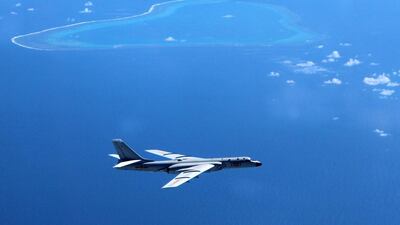The symbolism of the recent port call by an American aircraft carrier in Vietnam cannot obscure the fact that the United States, under two successive presidents, has had no coherent strategy for the South China Sea. It was on Barack Obama's watch that China created and militarised seven artificial islands, while his successor, Donald Trump, still does not seem to have that critical sub-region on his radar.
In fact, with Mr Trump focused on North Korea and trade, China is quietly pressing ahead with its expansionist agenda in the South China Sea. At the expense of its smaller neighbours, it is consolidating its hold by constructing more military facilities on the manmade islands and dramatically expanding its presence across the Indian Ocean and the western Pacific.
These developments carry far-reaching strategic implications for the international maritime order. They also highlight that the biggest threat to maritime peace and security comes from unilateral changes to the territorial or maritime status quo.
The Indo-Pacific region, which extends from the western shores of the US to the Gulf and eastern Africa, is so interconnected that adverse developments in any of its sub-regions impinge on wider maritime security. For example, it was always known that if China had its way in the South China Sea, it would turn its attention to the Indian Ocean and the western Pacific. This is precisely what is happening now. An emboldened China has also claimed to be a "near-Arctic state" and unveiled plans for a "polar Silk Road."
In fact, China is now using a super-dredger, dubbed a "magical island-building machine," in the South China Sea. China's latest advances are not as eye-popping as its creation of artificial islands. Yet the under-the-radar movement positions China to potentially dictate terms in the South China Sea. Last year alone, China built permanent facilities on 290,000 square meters of newly reclaimed land, according to the Asia Maritime Transparency Initiative.
In this light, US Freedom of Navigation Operations in the South China Sea cannot make up for the absence of an American strategy.
Indeed, China’s cost-free change of the status quo in the South China Sea has resulted in costs for other countries, especially in Asia.
Against this background, the rapidly changing maritime dynamics in the Indo-Pacific not only inject strategic uncertainty but also raise geopolitical risks.
Today, the fundamental choice in the region is between a liberal, rules-based order and an illiberal, hegemonic order.
There is consensus among all important players other than China for an open, rules-based Indo-Pacific. Playing by international rules is central to peace and security. Yet progress has been slow and tentative in promoting wider collaboration to advance regional stability and power equilibrium.
For example, the institutionalisation of the Australia-India-Japan-US “Quad” has yet to take off. The Quad, in fact, remains largely aspirational. In this light, the idea of a “Quad plus two” to include France and Britain seems overly ambitious at this stage.
If and when the Quad takes concrete shape, Britain and France could, of course, join. They both have important naval assets in the Indo-Pacific. During French President Emmanuel Macron's recent New Delhi visit, France and India agreed to reciprocal access to each other's naval facilities, on terms similar to the US-India Logistics Exchange Memorandum of Agreement (LEMOA).
Unless the Quad members start coordinating their approaches to effectively create a single regional strategy and build broader collaboration with other important players, Indo-Pacific security could come under greater strain.
If, under such circumstances, Southeast Asia, a region of 600 million people, is coerced into accepting Chinese hegemony, it will have a cascading geopolitical impact in the Indo-Pacific and beyond. China has employed a dual strategy of inducement and coercion to divide and manage the countries of Southeast Asia.
In the South China Sea, China is unlikely to openly declare an Air Defence Identification Zone as it did in the East China Sea. Rather it is expected to seek to enforce such a zone by gradually establishing concentric circles of air control after it has deployed sufficient military assets on the manmade islands and consolidated its hold over the sub-region.
China could also declare “straight baselines” in the Spratlys, as it did in the Paracels in 1996. Such baselines connecting the outermost points of the Spratly island chain would seek to turn the sea within, including features controlled by other nations, into “internal waters.”
To arrest China’s further designs in the South China Sea and its attempts to change the maritime status quo in the Indian Ocean and the East China Sea, a constellation of like-minded states linked by interlocking strategic cooperation has become critical to help institute power stability. The imperative is to build a new strategic equilibrium, including a stable balance of power.
Brahma Chellaney is a geostrategist and the author of nine books, including the award-winning Water: Asia’s New Battleground.

